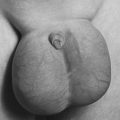51. Lown-Ganong-Levine Syndrome
Definition
Lown-Ganong-Levine (LGL) syndrome is a preexcitation syndrome producing supraventricular tachycardia that is neither atrial fibrillation nor atrial flutter. This syndrome is characterized by a short P-R interval (<20 milliseconds) and normal QRS complexes.
Incidence
The incidence of LGL syndrome is estimated to be approximately 0.5% worldwide.
Etiology
Some evidence suggests that LGL is a hereditary condition in some families. No definitive structural/anatomic anomaly has been identified as yet. Many experts believe that LGL is not a syndrome itself, but a manifestation of any of several maladies.
Signs and Symptoms
• Chest pain
• Hypotension
• Lightheadedness
• Palpitations
• Paroxysmal tachycardia
• Shortness of breath
Medical Management
There is no medical treatment specifically for LGL syndrome. Interventions are directed at identifying and resolving the cause of the tachycardia. When episodes produce symptoms, hospitalization is indicated, with the priority being to gain control of the patient’s ventricular heart rate. Immediate measures include Valsalva maneuver and/or carotid massage if there are no carotid bruits. Failure of these measures to interrupt the tachydysrhythmia may indicate the need to administer adenosine during continuous electrocardiography monitoring and recording. Treatment of the episodic paroxysmal supraventricular tachycardia may be undertaken on an outpatient basis. Pharmacologic treatment options include β-blocking medications, calcium channel–blocking medications, and digoxin. In the most extreme conditions/scenarios, radiofrequency ablation of either the AV node or bundle of His may be indicated. After successful pathway ablation, a pacemaker must be implanted.
Complications
Any complications are attributable to the underlying condition.
Anesthesia Implications
Frequently the patient with LGL presents for accessory pathway ablation. As such, pharmacologic interventions are usually stopped to aid in inducing a tachydysrhythmia. The patient is pharmacologically unprotected. Anxiolysis is important to lessen the chance of inciting a tachydysrhythmia in relatively uncontrolled surroundings, such as the patient’s room, the elevator, and/or the anesthesia holding room. Relatively heavy premedication is most helpful in achieving the desired degree of anxiolysis. If a tachydysrhythmia occurs, it may be controlled using very short-acting agents, such as esmolol or adenosine.







